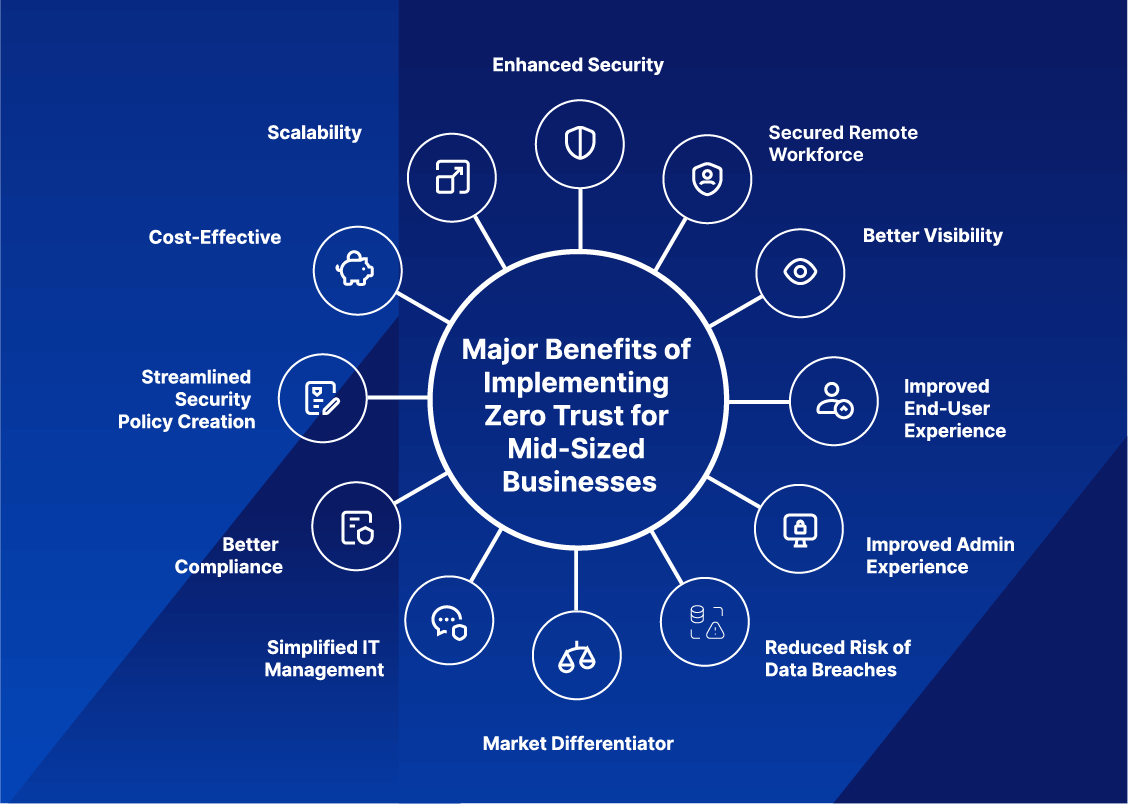Contents:
Zero Trust security is evolving from “nice to have” to an absolute must for organizations everywhere. Fortunately, Zero Trust offers numerous advantages to companies of all sizes, including medium-sized ones.
While achieving full implementation of Zero Trust for mid-sized businesses is a long-term goal, even adopting partial Zero Trust environments can help organizations of this size enhance their security posture and benefit in several other areas.
Benefits of Zero Trust for Mid-sized Businesses
Enhanced Security
One of the most important advantages of adopting a Zero Trust security model is improved protection. Zero Trust architecture focuses on securing all resources and access points, whether inside or outside the network. This approach can help businesses reduce the risk of data breaches and cyberattacks by ensuring that only authorized users and devices can access their sensitive data.
Secured Remote Workforce
Firewalls are no longer enough when users are spread across the globe, and data is spread across the cloud. When it comes to the Zero Trust approach, identity is the perimeter. Identity is linked to the users, devices, and programs trying to get access, providing strong protection for employees and data anywhere in the world.
Better Visibility
By implementing a Zero Trust approach, mid-sized companies can have better visibility into who is accessing their network and what resources they are accessing. This is due to the fact that Zero Trust requires that all users and devices be authenticated and authorized before getting access to any resources, which means all access attempts are logged and tracked. This gives sysadmins a clear view of who is accessing their network and what assets they are accessing, enabling them to identify and respond to any attempts at unauthorized access.
Also, a Zero Trust solution can help businesses implement granular access controls based on user roles, privileges, and context. This allows admins to define access policies that are customized to specific users or groups, restricting access to only the resources they need to do their job. This not only enhances security but also provides better visibility into what resources are being accessed by whom.
Improved End-User Experience
Zero Trust technologies can help provide seamless authentication to users, allowing them to access resources faster and more efficiently. Multi-Factor Authentication (MFA) and Single Sign-On (SSO) allow users to log in once and automatically gain access to all the resources they need without having to repeatedly enter their login information.
Also, because users get access only to the resources they need to perform their tasks based on role and privileges, they don’t have to waste time going through irrelevant resources and can access only the necessary ones. This makes their work more efficient. As mentioned before, a Zero Trust approach provides better security, which in turn can improve the user experience. When users know that their valuable information and assets are protected, they feel more secure and confident while working. This can improve their productivity and reduce their anxiety about potential security breaches.
Improved Admin Experience
Zero Trust security not only improves the user experience but also provides a better experience for IT admins, helping them work smarter. Zero Trust recommends software-driven architecture that improves visibility and makes management easier (particularly in hybrid and remote environments.)
This reduces IT’s workload, streamlines security management, and boosts their ability to identify and deal with threats more quickly. In medium-sized businesses where IT staff may be stretched, this saved time can be used to make a significant impact on other IT-related tasks without compromising on protection.
Reduced Risk of Data Breaches
Data breaches are a huge concern for organizations of all sizes, and implementing a Zero Trust security strategy can significantly minimize the risk of such threats. If you enforce rigorous authentication and authorization protocols, you can rest assured that only authorized users can obtain access to confidential information. Furthermore, the Zero Trust architecture allows you to build a safe environment for detecting and preventing unauthorized access and malicious behavior within your network.
Market Differentiator
Customers are increasingly prioritizing vendor security. With growing concerns around data privacy, both organizations and individual consumers want to be sure that their sensitive information is protected when provided to a third party. Therefore, security can serve as a noteworthy distinguishing factor when it comes to vendor selection.
In case your competitors haven’t adopted the Zero Trust approach, highlighting your company’s Zero Trust practices can provide a notable advantage. Bolstering your security measures and including your Zero Trust practices in your messaging can help you maintain a competitive advantage in your business.
Simplified IT Management
As Zero Trust is built on a foundation of ongoing monitoring and analytics, the process of evaluating access requests can be automated. If the Privileged Access Management (PAM) system determines that the key identifiers in the request are low-risk, access is given automatically. Not every request must be approved, only those flagged as suspicious by the automated system.
This is a considerable advantage. Why? The more processes a company can safely automate, the less human resources it will require and the more time IT teams will have to spend on development and manual administration.
Better Compliance
Zero Trust for mid-sized businesses also helps to comply with industry regulations and data protection laws. The Zero Trust architecture ensures that access to sensitive data is restricted only to authorized personnel and devices, which can help businesses meet compliance requirements.
There are two notable requirements that stand out in this context: the European Union’s General Data Protection Regulation (GDPR) and the California Consumer Privacy Act (CCPA). Despite their differences, both legislations require that organizations under their purview gather, store, and process information in accordance with strict guidelines. For a company subject to GDPR, CCPA, or both, adopting a Zero Trust approach to its compliance regime would be beneficial. This approach makes sure that only authorized individuals and systems have access to and can manage the protected data.
Streamlined Security Policy Creation
Traditional security models adopted a siloed strategy for threat prevention, meaning that every security technology was separately set up and used independently from the others. As a result, certain segments of the infrastructure were frequently left exposed due to security technologies being misplaced on the network or misconfigured.
Zero Trust is beneficial in this aspect as it allows for the creation of a universal policy that can be implemented end to end across the entire company. The Single Sign-On service is an excellent example of this, as it handles authentication for all resources on the entire network. The implementation and administration of security policies become significantly more straightforward for administrators, and the probability of security vulnerabilities in some areas of the infrastructure decreases significantly.
Cost Effectiveness
Implementing a Zero Trust security model can be cost-effective in the long run, which is especially important for mid-sized businesses with limited budgets. You can save money on potential legal fees, fines, and lost revenue by reducing the risk of data breaches and other security incidents. Additionally, with enhanced visibility and control, you can quickly detect and respond to potential security breaches, reducing the recovery cost.
Scalability
Finally, a Zero Trust security model is highly scalable. As your business grows and evolves, you can easily adapt the model to meet your changing security needs. This means adding new users, devices, and applications to your network without sacrificing security.

Heimdal®’s Approach to Zero Trust
To implement Zero Trust for mid-sized businesses, a multi-layered strategy is needed, including defining assets, creating a risk profile, establishing identity and access management, applying layered authentication, monitoring network activity, implementing the least privilege security strategy, and last but not least, ensuring that you remove the possibility for surprises, unwanted and unapproved phenomena on the machines/endpoints. These actions are essential for protecting corporate assets and reducing the likelihood of a cyberattack.
Privileged Access Management (PAM), Application Control, and Internet Traffic control tools can play an essential part in covering numerous of the above actions.
Looking at Zero Trust from the user access perspective, Privileged Access Management (PAM) adopts a centralized approach to managing and limiting access to critical data and systems, making sure that users, after they are authorized, have only the right permissions they need to do their job.

Heimdal® Privileged Access Management
- Automate the elevation of admin rights on request;
- Approve or reject escalations with one click;
- Provide a full audit trail into user behavior;
- Automatically de-escalate on infection;
Heimdal’s Privilege Elevation and Delegation Management (PEDM) product might be the perfect solution for your organization. Our solution will provision your users with Just-In-Time administrative rights in a seamless, secured, and controlled way. This will enable them to elevate certain pre-approved applications to administrator level or new applications upon request and approval by IT while removing the risk of them having a local administrator account (which will immediately dispel/disable/destroy the Zero Trust strategy that your organization invested so much in establishing).
Moreover, it also contains a Zero Trust Execution Protection technology that will immediately block any software missing a trusted certificate, eliminating the risk of executing malicious software on their machines.
FAQs
What is Zero Trust in cybersecurity?
Zero Trust is a security framework that assumes no trust, even among users and devices inside the corporate network. It requires continuous authentication and strict access controls to improve security.
Why is Zero Trust important for businesses of all sizes?
Zero Trust is crucial because traditional perimeter-based security is no longer sufficient to protect against modern cyber threats. It helps organizations protect sensitive data and prevent breaches.
How does Zero Trust affect user access to resources?
Zero Trust enforces the principle of “least privilege,” meaning users are only granted access to the specific resources they need for their jobs. Access is continuously monitored and adjusted based on user behavior.
What are the key components of a Zero Trust architecture?
A Zero Trust architecture typically includes components such as identity and access management (IAM), multi-factor authentication (MFA), micro-segmentation, continuous monitoring, and encryption.
Alternatively, follow us on LinkedIn, Twitter, Facebook, and YouTube for more cybersecurity news and topics.










 Network Security
Network Security
 Vulnerability Management
Vulnerability Management
 Privileged Access Management
Privileged Access Management  Endpoint Security
Endpoint Security
 Threat Hunting
Threat Hunting
 Unified Endpoint Management
Unified Endpoint Management
 Email & Collaboration Security
Email & Collaboration Security








